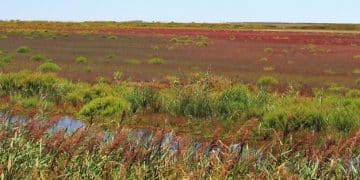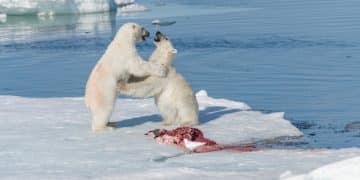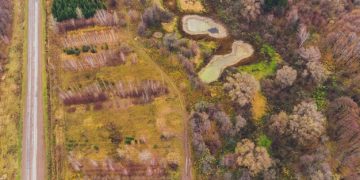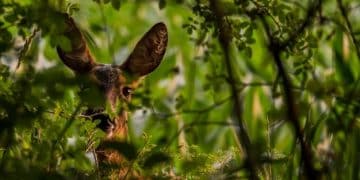Effective Methods to Reduce Human-Wildlife Conflict in the US

The most effective methods for reducing human-wildlife conflict in the US involve a combination of habitat management, preventative measures such as fencing and deterrents, community education, and policy implementation that supports coexistence.
Human-wildlife conflict is a growing concern in the US, impacting both communities and wildlife populations. Identifying and implementing what are the most effective methods for reducing human-wildlife conflict in the US is crucial for fostering coexistence and conservation efforts.
Understanding Human-Wildlife Conflict in the US
Human-wildlife conflict arises when the needs of humans and animals overlap, leading to negative interactions. In the US, this manifests in various forms, from crop damage caused by deer to livestock depredation by predators and even encounters with bears in residential areas.
Understanding the underlying causes and the extent of these conflicts is the first step toward finding effective solutions. Climate change, habitat loss, and increasing human populations all contribute to escalating these interactions.
Common Types of Human-Wildlife Conflict
Different regions of the US experience unique types of human-wildlife conflict based on local ecosystems and prevalent species.
- Agricultural Damage: Wildlife such as deer, elk, and rodents can inflict significant damage to crops and agricultural lands.
- Livestock Predation: Predators including wolves, coyotes, and bears sometimes prey on livestock, causing economic losses for farmers.
- Property Damage: Animals like beavers can cause flooding by damming streams, while others might damage homes and gardens.
- Human Safety: Encounters with large predators or venomous animals can pose a direct threat to human safety.
Effective conflict reduction strategies must address the specific types of conflicts present in a given area, taking into account the behavior and ecology of the wildlife involved.
Habitat Management and Conservation
Habitat management plays a vital role in reducing human-wildlife conflict by ensuring wildlife has sufficient resources within their natural environment.
Creating and maintaining healthy habitats minimizes the need for animals to venture into human-dominated landscapes in search of food, water, or shelter.
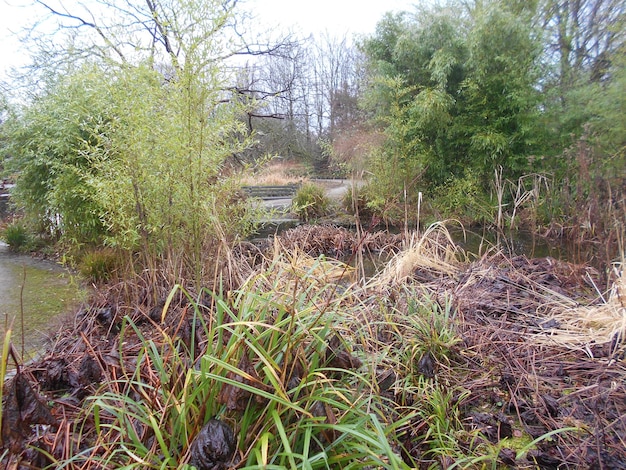
Creating Wildlife Corridors
Wildlife corridors are critical for connecting fragmented habitats, enabling animals to move freely and access necessary resources without crossing human infrastructure.
These corridors can be established through land conservation, habitat restoration, and the construction of wildlife crossings over or under roads.
Restoring Natural Food Sources
Enhancing natural food sources within wildlife habitats helps to keep animals away from agricultural fields and gardens.
This can involve planting native vegetation, managing forests to promote berry production, and restoring wetlands to support waterfowl.
In conclusion, habitat management is an important component of long-term conflict reduction. It addresses the root causes of conflict by creating environments that can sustain healthy wildlife populations, which minimizes the need for animals to seek resources in human areas.
Preventative Measures and Deterrents
Preventative measures and deterrents play a crucial role in mitigating human-wildlife conflict by keeping animals away from areas where they can cause damage or pose a threat.
These strategies can range from physical barriers like fencing to non-lethal methods like sound and light deterrents.
Fencing and Barriers
Fencing is one of the most effective ways to protect crops, livestock, and property from wildlife. The type of fencing can vary depending on the species targeted and the scale of the operation.
Electric fences are particularly useful for deterring large predators like bears and wolves, while woven wire fences can keep out deer and other herbivores.
Non-Lethal Deterrents
Non-lethal deterrents offer humane alternatives to lethal control methods. These include:
- Motion-Activated Lights and Sprinklers: These devices startle animals and discourage them from approaching.
- Sound Deterrents: Ultrasonic devices or propane cannons can produce sounds that deter wildlife.
- Taste Aversives: Applying bitter-tasting substances to crops or plants can discourage animals from feeding on them.
Investing in preventative measures can yield significant long-term benefits by reducing the frequency and intensity of human-wildlife interactions.
Community Education and Awareness
Community education and awareness programs are essential for fostering a culture of coexistence between humans and wildlife.
By providing accurate information about wildlife behavior, safety precautions, and responsible practices, these programs empower communities to live harmoniously with their wild neighbors.
Workshops and Outreach Programs
Local organizations, wildlife agencies, and conservation groups often offer workshops and outreach programs to educate residents about wildlife safety. These programs may cover topics such as:
- Bear Safety: How to store food properly, what to do during an encounter, and how to use bear spray.
- Deer Management: Tips for protecting gardens from deer damage and responsible hunting practices.
- Coyote Awareness: Understanding coyote behavior and how to prevent conflicts with pets.
Promoting Responsible Practices
Education can also promote responsible practices that reduce the likelihood of conflict, such as:
- Proper Waste Management: Securing garbage cans to prevent animals from accessing food waste.
- Pet Management: Keeping pets indoors at night and using leashes when walking them in wildlife areas.
- Avoiding Wildlife Feeding: Never intentionally feeding wildlife, as this can habituate them to human presence and create dependency.

In summary, community education is a vital tool for creating informed and responsible communities who are better equipped to coexist peacefully with local wildlife.
Policy Implementation and Regulations
Policy implementation and regulations play a crucial role in shaping human behavior and managing wildlife populations to minimize conflict.
Effective policies can provide the framework for balancing human needs with the conservation of wildlife.
Land-Use Planning
Land-use planning that takes wildlife into account can help to prevent future conflicts. This includes:
- Zoning Regulations: Establishing buffer zones between residential areas and wildlife habitats.
- Conservation Easements: Protecting critical wildlife areas from development.
- Mitigation Measures: Requiring developers to implement measures to offset the impact of new construction on wildlife.
Wildlife Management Regulations
Regulations governing hunting, trapping, and other forms of wildlife management can also help to reduce conflict.
This includes:
- Hunting Seasons and Bag Limits: Regulating the harvest of wildlife to maintain healthy population levels.
- Protected Species: Establishing protections for endangered or threatened species that may be involved in conflicts.
- Relocation Programs: Moving problem animals to areas where they are less likely to cause conflict.
Therefore, by integrating sound science with public input, policymakers can create regulations that promote coexistence while protecting both human interests and biodiversity.
Research and Monitoring
Research and monitoring are essential components of human-wildlife conflict management.
By studying wildlife behavior, population dynamics, and conflict hotspots, researchers can provide valuable insights that inform effective mitigation strategies.
Tracking Wildlife Movements
GPS tracking and other technologies can provide valuable data on how wildlife use the landscape and interact with human infrastructure.
This information can be used to:
- Identify Conflict Hotspots: Pinpoint areas where human-wildlife interactions are most frequent.
- Assess the Effectiveness of Mitigation Measures: Evaluate how well different strategies reduce conflict.
- Inform Land-Use Planning: Guide the development of wildlife corridors and protected areas.
Monitoring Wildlife Populations
Monitoring wildlife populations can help to detect changes in abundance and distribution that may increase the risk of conflict.
This includes:
- Aerial Surveys: Counting wildlife from aircraft to estimate population sizes.
- Camera Trapping: Using remote cameras to monitor wildlife activity.
- Citizen Science Programs: Enlisting volunteers to collect data on wildlife sightings.
Robust research and monitoring programs are therefore critical for adapting management strategies to changing conditions and ensuring the long-term success of conflict reduction efforts.
Collaboration and Partnerships
Effective management of human-wildlife conflict requires collaboration and partnerships among various stakeholders.
These collaborations foster shared responsibility and leverage diverse expertise to achieve common goals.
Government Agencies
Federal, state, and local agencies play a central role in wildlife management and conflict resolution.
This includes:
- US Fish and Wildlife Service: Overseeing the protection of endangered and threatened species.
- State Wildlife Agencies: Managing wildlife populations and implementing conflict reduction programs.
- Local Governments: Enforcing land-use regulations and addressing local conflicts.
Non-Governmental Organizations
Conservation organizations, advocacy groups, and research institutions contribute expertise, funding, and public support to conflict reduction efforts.
This includes:
- Providing Technical Assistance: Offering guidance and support to landowners and communities.
- Conducting Research: Evaluating the effectiveness of different mitigation strategies.
- Advocating for Policy Changes: Promoting policies that support coexistence.
All in all, by breaking down silos and promoting open communication, collaborative partnerships build a more resilient and effective system for managing human-wildlife conflict.
| Key Point | Brief Description |
|---|---|
| 🏡 Habitat Management | Ensuring wildlife has sufficient resources through well-managed natural habitats. |
| 🚧 Preventative Measures | Using fencing and other deterrents to keep wildlife away from human areas. |
| 📚 Community Education | Educating communities about wildlife behavior and safety practices. |
| ⚖️ Policy Implementation | Implementing policies that balance human needs with wildlife conservation. |
Frequently Asked Questions
▼
Human-wildlife conflict arises when interactions between humans and wildlife lead to negative impacts on either human interests or wildlife conservation. This can involve property damage, threats to human safety, or harm to wildlife populations.
▼
Several factors contribute to the increase in human-wildlife conflict, including habitat loss, human population growth, and changes in climate patterns. These can force animals to seek resources in human-dominated landscapes.
▼
Habitat management ensures that wildlife has adequate food, water, and shelter within their natural environment. This reduces the likelihood that animals will venture into agricultural fields or residential areas in search of resources.
▼
Effective non-lethal deterrents include motion-activated lights and sprinklers, sound deterrents like ultrasonic devices, and taste aversives applied to crops or plants. These methods discourage animals without causing harm.
▼
Community education empowers residents to live safely and responsibly alongside wildlife. It promotes responsible stewardship of the environment and can foster a culture of coexistence based on respect and understanding.
Conclusion
In summary, reducing human-wildlife conflict in the US requires a multi-faceted approach that integrates habitat management, preventative measures, community education, policy implementation, research, and collaboration to foster long-term coexistence.
